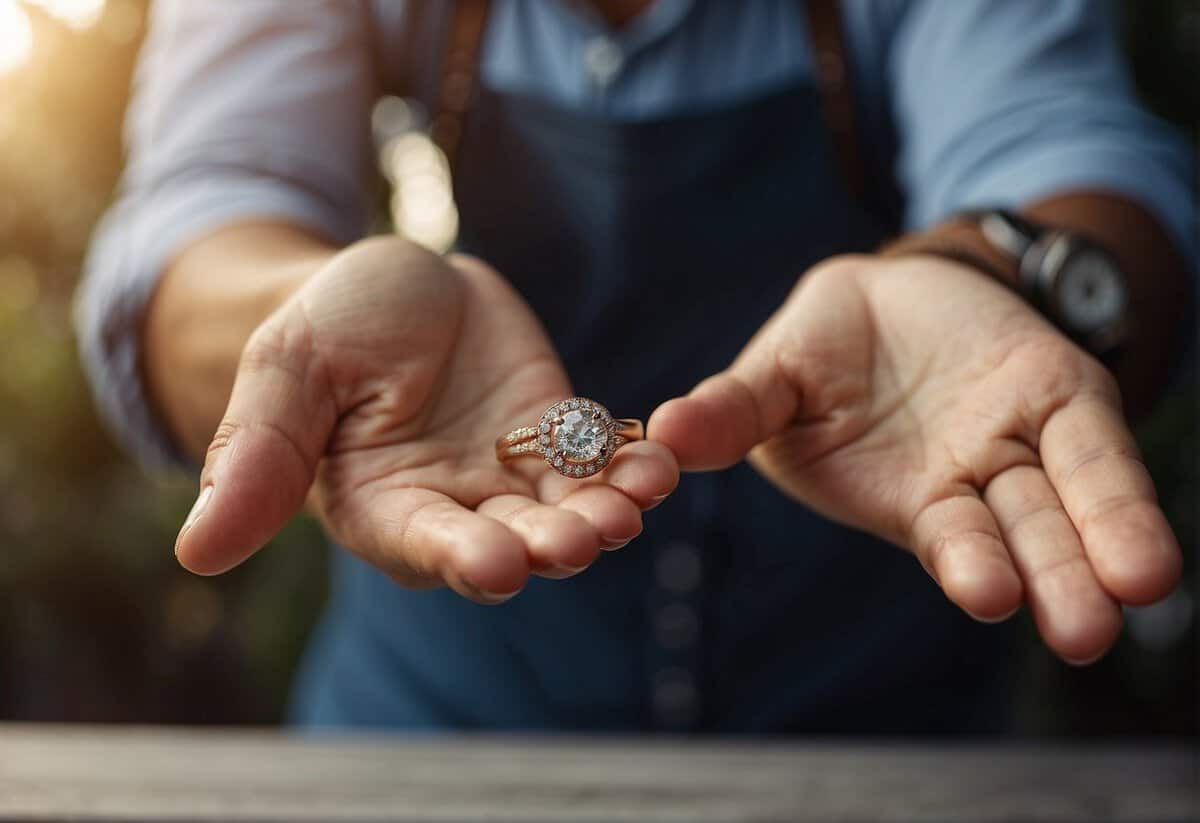Why Does a Guy Not Wear an Engagement Ring? Unveiling Social Norms
Traditionally, engagement rings have been seen as symbols of love and commitment, often worn by women once they agree to marry. The practice of men not wearing engagement rings mainly stems from historical gender roles where such a symbol was deemed unnecessary for men. Furthermore, given that historically the role of men in marriage was not viewed as being ‘claimed’ or ‘taken,’ there was no cultural or social requirement for men to display signs of betrothal.

In more recent times, the conversation about engagement rings for men has been evolving. Now, your personal preference and the shifting views on gender roles play a significant role in jewelry choices. While some men do embrace the idea of wearing engagement rings, others may opt not to due to tradition, societal norms, or personal taste. The norms and customs around engagement rings and who wears them vary greatly across different cultures and countries, illustrating the diversity in global perspectives on engagement practices.
Key Takeaways
- Engagement rings for women are deeply rooted in tradition, signifying betrothal.
- Men traditionally haven’t worn engagement rings due to historical gender norms.
- Contemporary views and personal preferences are influencing a change in who wears engagement rings.
Historical Context of Engagement Rings

In your journey to understand why typically men don’t wear engagement rings, it’s essential to uncover the layered past of ring exchange and the historical progression of engagement rings themselves.
Origins and Evolution of Ring Exchange
The tradition of exchanging rings as a symbol of love dates back to ancient Egypt, where rings were fashioned from materials like hemp and leather. These rings, placed on the fourth finger of the left hand, were believed to be connected directly to the heart by the “vena amoris” or vein of love. As you move through time, the Romans adopted the custom, but with a twist—they used betrothal rings as a symbol of ownership rather than love.
The exchange of rings steadily evolved into a mutual exchange, although this has predominantly been a Western tradition. There were variations; for example, in some European countries, only women wore engagement rings as a sign of their betrothal.
Engagement Rings Through the Ages
Fast forward to the Middle Ages, betrothal rings become more ornate, often set with gems to symbolize nobility and wealth. These rings were treasured as keepsakes and symbols of commitment. However, the diamond engagement ring that you’re familiar with today did not become a cultural cornerstone until after a powerful marketing campaign by De Beers in the 20th century, which solidified the diamond’s status in engagement traditions.
The phrase “A Diamond is Forever” and associated campaigns not only boosted diamond sales but also cemented the expectation that women would receive diamond engagement rings. The custom of men wearing engagement rings is still less common—a reflection of deep-rooted cultural traditions that are only now starting to shift.
Contemporary Gender Roles and Jewelry

In recent years, you’ve likely noticed shifts in how society views gender roles, particularly in how they relate to the jewelry we wear, like engagement rings. These changes reflect evolving perceptions of equality and self-expression.
Gender Norms in Modern Society
Gender norms have traditionally dictated that women wear engagement rings as a sign of commitment, while men typically did not. The idea was rooted in historical ownership concepts, with rings symbolizing a woman’s betrothal to a man. However, as societal norms change, so too does the acceptance of men wearing engagement rings. These stereotypes are being challenged by an increasing number of men who choose to wear engagement rings as a visible symbol of their impending marriage, mirroring the custom for women.
Jewelry as a Symbol of Gender Identity
Jewelry often serves as an expression of one’s personal and gender identity. As gender roles become more fluid, the jewelry that one chooses to wear—including engagement rings—becomes a reflection of their identity rather than a compliance with outdated norms. The modern viewpoint transcends traditional gender boundaries, allowing for a variety of self-expression through jewelry choices among all genders. Men wearing engagement rings is a testament to this shift, celebrating the idea that commitment symbols don’t have to be gender-specific.
Personal Preferences and Choices

When it comes to engagement rings, your personal preference plays a pivotal role. Selecting a ring is a reflection of your style and values, and there’s a wide variety of metals and gems to choose from that align with your individual taste.
Choosing Metals and Gems
Metals:
- Platinum: Known for its strength and durability, platinum is a popular choice that exudes sophistication.
- Rose Gold: Offers a warm, vintage appeal that’s become increasingly popular in recent years.
- Silver: A classic choice that provides a timeless look and aligns with a more modest budget.
Gems:
- Emerald: If you seek something outside the traditional, an emerald offers a unique and rich green hue.
- Sapphire: For a touch of royal elegance, sapphires present a durable and vibrant alternative to diamonds.
Remember, the choice of the metal and the gem for your engagement ring is an expression of your personal narrative. Whether you lean towards the luxurious feel of platinum or the warm glow of rose gold, your ring can be as distinctive as you are. Similarly, opting for gems like sapphire or emerald can set your ring apart and make a statement that resonates with your personal choice.
Global Perspectives on Engagement Practices

When you explore different cultures, you’ll find that the custom of exchanging engagement rings varies greatly. Factors like local traditions, the significance of jewelry in conveying relationship status, and personal preferences all play a part in whether men wear engagement rings.
Engagement Traditions Around the World
In Chile, it’s customary for both partners to wear engagement rings on their right hands. When they marry, the rings are moved to the left hand, symbolizing the transition from engagement to marriage. This practice reflects a more egalitarian approach to engagement and marriage jewelry.
Heading south to Argentina, couples often exchange rings at their engagement without specifying one for the bride or groom. This approach showcases a preference for symmetry in the representation of their commitment.
Cultural traditions greatly influence engagement practices. In many countries, engagement rings are predominantly worn by women as a symbol of their intention to marry. However, this is not a universal standard, and as societies evolve, so do their customs relating to engagement rings.
Often, the choice for a man to wear an engagement ring boils down to personal preferences and what the ring symbolizes in their specific cultural setting. Some men choose rings to reflect their imminent change in relationship status, while others might opt out due to local norms or personal taste.
Factors such as the size and style of the ring can also be a consideration, especially if a man is not accustomed to wearing jewelry. A subtle band may be more common among men who prefer minimalist designs or who are not used to wearing rings.
Talking about engagement ring practices around the globe opens your eyes to the rich tapestry of how love and commitment are celebrated differently in each culture. As global perspectives continue to shift, you might see more men embracing this tradition in their own ways.
Frequently Asked Questions

When you’re curious about the traditions and norms surrounding men and engagement rings, you’re not alone. These FAQs tackle common inquiries in this area.
Is it common for men to wear engagement rings?
It’s becoming more accepted for men to wear engagement rings, especially as gender roles evolve. However, this is still not as common as women wearing them.
What cultural traditions involve men wearing engagement rings?
In some cultures, such as those in Sweden and Chile, men have traditionally worn engagement rings. This shows that the practice varies widely around the world.
In relationships, do both partners typically receive an engagement ring?
While it’s typical for only women to receive an engagement ring in many places, there’s a growing trend where both partners exchange rings, especially in male same-sex relationships.
How common is it for men to wear their engagement rings on the right hand?
Wearing engagement rings on the right hand can be a cultural marker or a personal choice, but specific data on this practice’s prevalence is not readily available.
What does it signify when a man doesn’t wear his wedding ring?
Not wearing a wedding ring can mean different things, like personal discomfort with jewelry or active professional restrictions; it does not necessarily indicate marital dissatisfaction.
What’s the percentage of men who choose to wear engagement rings?
According to a 2019 study by The Knot, about 7% of men wear engagement rings, a figure that is increasing as more men embrace this symbol of commitment.

